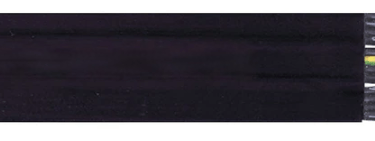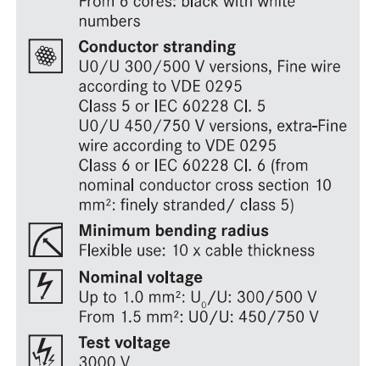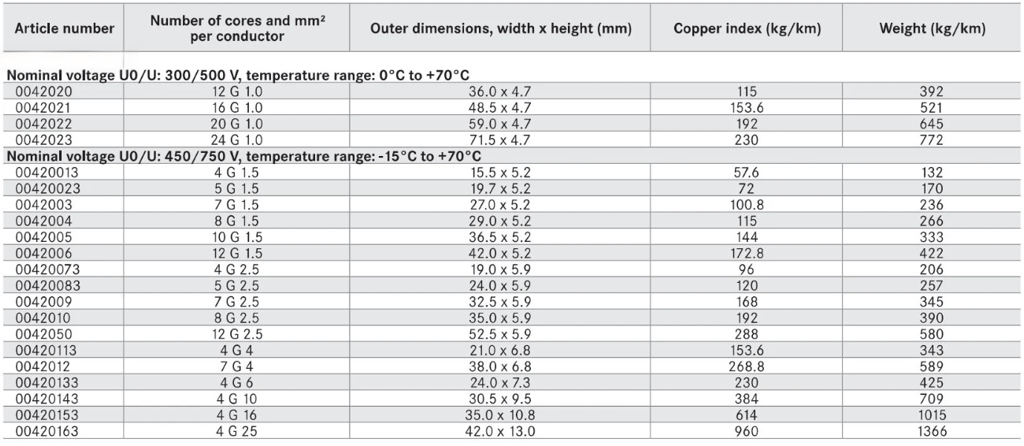📞+86 153 7530 2641 📧 hongjing.Wang@feichuncables.com

H07VVH6-F Flat Cables PVC Control Cable: Highly Flexible Power & Control Solution for Cable Trolleys, Elevators, and Hoisting Systems
Discover the H07VVH6-F PVC flat control cable—a space-saving, highly flexible power and control cable for cable trolleys, elevators, indoor cranes, and conveyor systems. Learn about its cold-temperature performance, small bending radius, VDE-certified lift control capability up to 35 m suspension, and 1.6 m/s travel speed.
hongjing.Wang@Feichun
8/13/20259 min read






1.1 Overview of H07VVH6-F Flat Cables
The H07VVH6-F flat cable represents a sophisticated engineering solution designed to meet the demanding requirements of modern industrial applications. This highly flexible PVC control cable combines exceptional mechanical properties with reliable electrical performance, making it an ideal choice for dynamic applications where conventional round cables fall short. The flat profile design offers unique advantages in space-constrained environments while maintaining the durability and flexibility essential for continuous motion applications.
The designation H07VVH6-F follows international cable coding standards, where "H" indicates harmonized European standards, "07" represents the nominal voltage rating, "VV" denotes PVC insulation and sheathing, "H6" specifies the flat cable construction, and "F" indicates flexible design characteristics. This systematic approach to cable designation ensures consistent quality and performance standards across different manufacturers and applications.
1.2 Importance of Space-Saving Cable Solutions
In today's industrial landscape, efficient space utilization has become increasingly critical. Manufacturing facilities, warehouses, and automated systems face mounting pressure to maximize operational efficiency while minimizing footprint requirements. Traditional round cables, while functional, often consume valuable installation space and present challenges in applications requiring frequent movement or tight bending radii.
The flat cable design philosophy addresses these challenges by redistributing conductor arrangement to create a lower profile without compromising electrical or mechanical performance. This approach enables installation in narrow cable guides, reduces wind resistance in moving applications, and allows for more compact cable management systems. The space-saving benefits extend beyond mere dimensional advantages, contributing to improved system aesthetics, reduced material costs, and simplified maintenance procedures.
1.3 Purpose and Scope of this Article
This comprehensive article examines the technical specifications, application scenarios, and performance characteristics of H07VVH6-F PVC flat control cables. The analysis covers detailed construction features, electrical properties, mechanical capabilities, and practical installation considerations. Additionally, the article addresses common application challenges and provides guidance for proper cable selection and implementation in various industrial environments.
The scope encompasses both theoretical understanding and practical application knowledge, ensuring readers gain comprehensive insight into when and how to effectively utilize these specialized cables in their specific applications. Whether you are a system designer, maintenance engineer, or procurement professional, this article provides the technical foundation necessary for informed decision-making.


1. Introduction
2. Technical Features of H07VVH6-F PVC Control Cable
2.1 Cable Construction and Materials
The H07VVH6-F cable features a sophisticated multi-layer construction designed to optimize both electrical performance and mechanical durability. The conductor arrangement utilizes fine-stranded copper wires, typically consisting of Class 5 or Class 6 stranding configurations according to IEC 60228 standards. This fine stranding provides exceptional flexibility while maintaining low electrical resistance and reliable current-carrying capacity.
The insulation system employs high-quality PVC compounds specifically formulated for dynamic applications. Each individual conductor receives a color-coded PVC insulation layer that provides electrical isolation and identification throughout the cable's service life. The insulation thickness is carefully calculated to meet voltage rating requirements while minimizing overall cable dimensions.
The outer sheath consists of a specially formulated PVC compound that offers superior mechanical protection, chemical resistance, and environmental durability. This sheath material undergoes rigorous testing to ensure resistance to oils, coolants, and other industrial fluids commonly encountered in hoisting and conveyor applications. The flat profile is achieved through specialized extrusion processes that maintain uniform wall thickness and optimal conductor spacing.
2.2 Nominal Voltage and Temperature Range
The H07VVH6-F cable series offers two distinct voltage and temperature specifications to accommodate diverse application requirements:
Standard Temperature Range (300/500 V, 0°C to +70°C): This specification serves general-purpose applications where ambient temperatures remain within moderate ranges. The 300V phase-to-ground and 500V phase-to-phase ratings provide adequate electrical safety margins for most control and power applications. The temperature range accommodates typical indoor industrial environments while ensuring reliable insulation performance throughout the cable's operational life.
Extended Temperature Range (450/750 V, -15°C to +70°C): This enhanced specification addresses applications requiring operation in cold environments or where higher voltage ratings are necessary. The extended low-temperature capability down to -15°C ensures reliable flexibility and electrical performance in unheated facilities, outdoor installations, or refrigerated environments. The increased voltage rating (450V phase-to-ground, 750V phase-to-phase) provides additional safety margins for higher-power applications.
The temperature specifications represent continuous operating ranges where the cable maintains full electrical and mechanical performance. Short-term temperature excursions beyond these ranges may be acceptable, but sustained operation outside specified limits can compromise cable life and reliability.
2.3 Highly Flexible Design
The exceptional flexibility of H07VVH6-F cables results from careful optimization of conductor design, insulation properties, and overall construction geometry. The fine-stranded copper conductors provide the foundation for flexibility, with individual wire diameters selected to minimize work hardening during repeated bending cycles.
Small Bending Radii Capability: The flat profile geometry enables significantly reduced bending radii compared to equivalent round cables. Typical minimum bending radii range from 4 to 6 times the cable height, depending on specific construction and application requirements. This capability proves particularly valuable in cable trolley systems, power chains, and elevator applications where space constraints demand tight routing configurations.
Flexibility at Cold Temperatures: The PVC compounds used in H07VVH6-F construction maintain flexibility even at reduced temperatures. Special plasticizers and polymer formulations ensure that cables remain pliable and bendable throughout the specified temperature range. This characteristic prevents cable stiffening in cold environments that could lead to excessive stress concentrations and premature failure.
2.4 Flat Profile Benefits
The flat cable geometry provides numerous practical advantages beyond simple space savings:
Space-Saving Installation: The reduced height profile allows installation in cable channels, guides, and supports with minimal clearance requirements. This efficiency enables more compact machine designs and reduced structural requirements for cable support systems.
Compatibility with Power Chains: The flat profile naturally complements energy chain systems, providing optimal cable routing through chain links while minimizing chain width requirements. The uniform cross-section reduces twisting and tangling during chain operation, contributing to extended system life.


4. Application Range
4.1 Hoisting Equipment and Conveyor Systems
H07VVH6-F cables excel in hoisting equipment applications where continuous motion, compact installation, and reliable performance are paramount. Overhead cranes, gantry cranes, and material handling systems benefit from the cable's ability to withstand repeated bending cycles while maintaining electrical continuity. The flat profile enables installation in narrow bridge girders and compact festoon systems.
Conveyor systems present unique challenges including exposure to industrial environments, frequent start-stop cycles, and varying load conditions. The H07VVH6-F design addresses these challenges through robust construction, appropriate chemical resistance, and optimized flexibility characteristics that accommodate conveyor motion patterns.
4.2 Cable Trolleys and Power Chains
Cable trolley applications represent one of the most demanding environments for flexible cables. The combination of continuous motion, confined space requirements, and exposure to industrial contaminants requires exceptional cable design. H07VVH6-F cables provide optimal performance through their flat profile geometry, which reduces drag forces and simplifies routing through trolley guides.
Power chain systems benefit from the cable's compatibility with standard chain link designs. The flat cross-section minimizes chain width requirements while providing excellent bend radius performance. Proper cable selection and installation in power chains can significantly extend system life and reduce maintenance requirements.
4.3 Indoor Cranes and High-Rack Facilities
Indoor crane installations demand cables that combine electrical reliability with mechanical durability. The H07VVH6-F series meets these requirements through optimized construction that withstands bridge crane motion patterns while providing reliable power and control signal transmission. The space-saving profile enables installation in compact crane designs where traditional round cables would be impractical.
High-rack facilities, including automated storage and retrieval systems, benefit from the cable's ability to operate in vertical orientations with minimal support requirements. The controlled flexibility prevents excessive cable sway while maintaining electrical performance throughout extended vertical runs.
4.4 Elevators and Lift Control Systems
Elevator applications represent a specialized subset of vertical motion systems with unique requirements for safety, reliability, and regulatory compliance. H07VVH6-F cables meeting VDE lift control standards provide appropriate solutions for elevator control systems, door operators, and auxiliary equipment.
The 35-meter suspension capability and 1.6 m/s travel speed specification align well with typical elevator performance requirements. However, specific elevator applications should always be verified against applicable codes and standards to ensure complete compliance with safety regulations.
4.5 Supply Line for Moving Machine Parts
Manufacturing equipment increasingly incorporates moving machine elements that require flexible power and control connections. H07VVH6-F cables address these applications through their combination of electrical performance and mechanical durability. Common applications include robotic systems, automated assembly equipment, and precision positioning systems.
The flat profile proves particularly valuable in applications where cable routing must accommodate complex machine geometries or where multiple cables must be routed in parallel configurations.


5. Installation and Maintenance Considerations
5.1 Routing in Confined Spaces
Proper cable routing in confined spaces requires careful attention to minimum bend radius requirements, support spacing, and thermal considerations. The flat profile of H07VVH6-F cables enables installation in narrow channels and guides, but proper support remains essential to prevent excessive stress concentrations.
Installation guidelines should address entry and exit transitions from confined spaces, ensuring that sharp edges or abrupt direction changes do not compromise cable integrity. Protective elements such as bend radius guides and edge protection may be necessary in challenging installations.
5.2 Bending Radius Guidelines
Adherence to manufacturer-specified bending radius limits is critical for achieving expected cable service life. The flat cable geometry enables reduced bending radii compared to round cables, but limits still apply to prevent conductor damage or insulation stress.
Dynamic bending applications require particularly careful attention to bend radius specifications, as repeated flexing can accelerate cable aging if proper limits are not observed. Installation planning should include verification that all bending radii throughout the cable route meet or exceed minimum specifications.
5.3 Temperature-Related Handling
Cable handling and installation procedures must account for ambient temperature conditions and expected operating temperatures. Cold temperature installations require special attention to cable flexibility, as PVC materials may temporarily stiffen until reaching operating temperature.
Thermal expansion and contraction effects should be considered in long cable runs or applications with significant temperature variations. Appropriate service loops or expansion provisions may be necessary to prevent excessive mechanical stress.
5.4 Inspection and Replacement Intervals
Preventive maintenance programs should include regular cable inspection to identify potential issues before failure occurs. Visual inspection should focus on sheath condition, bend radius compliance, and signs of mechanical wear or chemical attack.
Electrical testing programs may include insulation resistance measurements, continuity verification, and specialized testing for specific application requirements. Replacement intervals depend on application severity, environmental conditions, and criticality of the specific installation.


6. Compliance and Certification
6.1 VDE Standards for Lift Control Cables
VDE (Verband der Elektrotechnik) standards provide comprehensive requirements for cables used in elevator and lift applications. These standards address construction requirements, performance specifications, and safety considerations specific to vertical transportation equipment.
H07VVH6-F cables meeting VDE lift control standards undergo rigorous testing to verify compliance with mechanical strength, electrical performance, and environmental resistance requirements. This certification provides assurance that cables will perform reliably in demanding elevator applications.
6.2 Safety and Quality Assurance
Manufacturing quality systems ensure consistent cable performance through controlled production processes, material verification, and comprehensive testing programs. Quality assurance extends beyond basic electrical and mechanical testing to include environmental resistance, aging characteristics, and long-term reliability validation.
Safety considerations encompass both installation safety and operational safety throughout the cable's service life. Proper cable selection, installation, and maintenance practices contribute significantly to overall system safety and reliability.
7. Product Selection Guide
7.1 Core Count and Conductor Size Options
Cable selection begins with determination of electrical requirements including voltage rating, current capacity, and signal transmission needs. The H07VVH6-F series offers configurations ranging from basic 4-core control cables to complex 25-core installations supporting multiple functions.
Conductor cross-section selection balances electrical performance requirements with mechanical flexibility needs. Larger conductors provide increased current capacity and reduced voltage drop but may compromise flexibility in demanding applications.
7.2 Weight and Dimension Selection Table
Physical specifications including cable weight, width, and height directly impact support system requirements and installation feasibility. The provided selection table enables accurate determination of these parameters based on specific core count and conductor size combinations.
Weight specifications prove particularly important in vertical applications where cable self-weight contributes to mechanical loading of support systems and termination points.
7.3 Application Profiles for Crane and Lift Cables
Manufacturer application profiles provide detailed guidance for specific installation types, including recommended cable configurations, installation practices, and maintenance procedures. These profiles represent accumulated experience and testing data specific to common application scenarios.
Reference to appropriate application profiles helps ensure optimal cable selection and installation practices for specific equipment types and operating conditions.


8. Conclusion
8.1 Summary of Benefits
H07VVH6-F PVC flat control cables represent an advanced solution for demanding power and control applications requiring exceptional flexibility, space efficiency, and reliable performance. The combination of flat profile geometry, optimized construction materials, and compliance with international standards creates a versatile cable series suitable for diverse industrial applications.
Key benefits include space-saving installation capabilities, excellent flexibility at both normal and cold temperatures, VDE-certified performance for lift control applications, and robust construction suitable for dynamic operating conditions. These characteristics make H07VVH6-F cables particularly well-suited for cable trolleys, elevators, indoor cranes, conveyor systems, and other applications involving continuous motion.
8.2 Recommendations for Application Scenarios
Selection of H07VVH6-F cables should be based on careful evaluation of electrical requirements, environmental conditions, mechanical demands, and regulatory compliance needs. The extended temperature range option (-15°C to +70°C) provides advantages for cold environment applications, while the standard temperature range offers cost-effective solutions for typical industrial environments.
Applications involving frequent motion, tight space constraints, or demanding environmental conditions will benefit most from the specialized characteristics of these flat cables. However, each installation should be evaluated individually to ensure optimal cable selection and proper installation practices.
How to Reach Us
Get in Touch
SiteMap
Product Catalogue
Reeling Cable
Festoon Cable
Shore Power Cable




Scan to add us on WeChat
